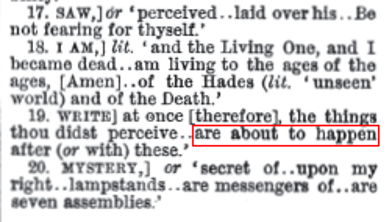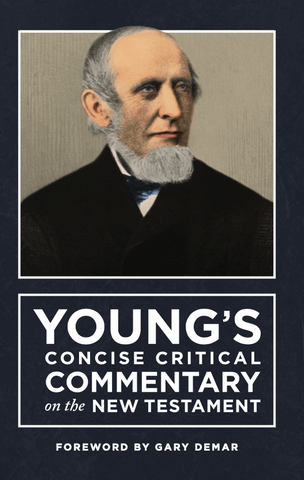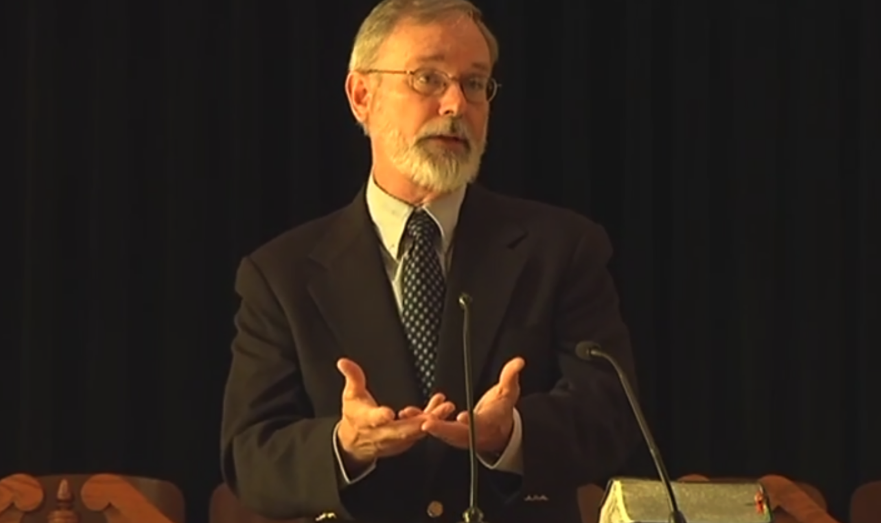Important Note: Gary DeMar’s Facebook page has been taken down. To keep up with the latest from Gary and American Vision or to continue the conversation from articles, podcasts, or videos, please go to the AV Facebook page here.
Ken Gentry keeps changing his views about preterism. That’s OK because we all make changes. I believe his charges are designed to avoid having to deal with challenges to the partial preterist position. Let’s begin with his claim that John Lightfoot was not a preterist even though he said in the past that Lightfoot was a preterist.
For several years I have stated that the Westminster divine and great Talmudic scholar John Lightfoot (1602-75) was a preterist. I was wrong. He was an historicist. (source)
Lightfoot was a historicist-preterist. This is not unusual, in fact, it’s typical. Here’s something from a late 17th century or early 18th century commentary on Revelation. The Opening “Argument” in “The Revelation of S. John the Divine” on the composition date of Revelation includes the following:
There is a further Argument of the Revelation being written early, from the governors of theChristian Churches being called therein Angels; for we find in the Epistle to Timothy, they are stiled Bishops or Overseers; which has ever since been the Title of the Superintendents of ChristianChurches: So that we may conjecture the Revelation was written before the Title of Bishops or Overseers was in Use; that is, at least before the Year of CHRIST 65.
…..
1:3 For the time is at hand:] The beginning of the Accomplishment of the Things here written is at Hand. — The civil Wars of the Romans, and the Destruction of the Jewish State, were probably the Things which were meant by the Time is at Hand. (916)
…..
1:7 This seems to be spoken of CHRIST’s Coming to execute Judgments upon the unbelieving Jews, and the Romans.[1] (917)
The unknown author of this commentary notes that some commentators relate chapters 1-11 “to the Jews, and include the Calamities which befell them before the Siege of Jerusalem by Titus.” Others extend the prophecy down to the end of the 20th chapter “to the Romans,” others “to much later Times, and even to modern ones,” and some even “the End of the World.” (925) This approach was common. Gentry’s two-volume commentary breaks with the preterist-historicist approach like no other commentary has. It’s nearly a full preterist commentary, and that’s a problem for Gentry.
Most commentators of that era were historicists. Even so, Lightfoot’s works are filled with preterist interpretations, as Gentry admits in the following. Take note of Matthew 24:27.
On Matt 24:27 [Lightfoot] writes: “The destruction of Jerusalem is very frequently expressed in Scripture as if it were the destruction of the whole world, Deut. xxxii. 22” (2:318)…. “According to this sense, Christ speaks in this place; and … John, in the sixth [chapter] of the Revelation” (2:318-19). He adds “Christ’s taking vengeance of that exceeding wicked nation is called Christ’s ‘coming in glory,’ and his ‘coming in the clouds,’ Dan. vii. . . . See Psalm i.4; Mal. iii. 1, 2, &c.; Joel ii. 31; Matt. xvi. 28; Rev. i. 7.”
On Mark 9:1 (2:422) he states: “The coming of Christ in his vengeance of the Jews is expressed under these forms of speech…. The vengeance of Christ upon that nation is described as … his ‘coming in the clouds,’ Rev. 1. 7.”
All of this sounds so preteristic! And these statements certainly do present a preterist understanding of these passages.
Why is Gentry dismissing an author like Lightfoot whose works are filled with preterist arguments? Why has Gentry changed his view of the Greek word mellō that he used to defend the pre-AD 70 date of Revelation? He lists Revelation 1:19 and 3:10 as part of a Μέλλω Word Group in his book Before Jerusalem Fell and the first edition of his The Beast of Revelation book. Here’s what he wrote in Before Jerusalem Fell (141):
Unfortunately, none of the major translations cited above translates Revelation 1:19 in a literal fashion. Although interestingly, several do translate the same verb in a more literal fashion when it appears in Revelation 3:10…. All of this is particularly significant when the contexts of these two occurrences of μέλλω [mellō] in Revelation are considered: the words appear in near proximity with statements made up of the two other word groups indicating “nearness.” Revelation 1:19 is preceded by Revelation 1:1 and 1:3 (which contain representatives of both the τάχος [tachos] and ἐγγύς [engus] word groups). Revelation 3:10 is followed by Revelation 3:11 (which contains a representative of the τάχος [tachos] word group). Clearly, then, the Revelation 1:19 and 3:10 references hold forth an excited expectation of soon occurrence.[2]
What Gentry wrote below is from pages 23-24 of the 1989 edition of The Beast of Revelation but was removed from the 2002 revised edition. He was flying too close to the full preterist sun, so he lowered his altitude so he would not be burned at the stake by the Protestant Popes and lose his publishing market.
The final term we can note is mellō, which means “about to” (Rev. 1:19; 3:10). When found in both of the verb forms appearing in Revelation 1:19 and 3:10, this term means ‘be on the point of, be about to.’ A number of Bible translations confuse the matter when they translate the word properly in Revelation 3:10 but improperly in Revelation 1:19. According to Young’s Literal Translation of the Bible, Revelation 1:19 reads: ‘Write the things that thou hast seen, and the things that are, and the things that are about to come [mellō] after these things.’ The leading interlinear versions of the New Testament concur. This is surely the proper translation of the verse.
Is Gentry now as “confused” as the Bible translations he mentioned? That was then, this is now. (I wonder if this shift had something to do with Gentry not debating Mark Hitchcock and not dealing with Hitchcock’s arguments in his Divorce of Israel commentary.)
Here’s what Gentry wrote about the nearness factor of μέλλω in Revelation 1:19 in The Divorce of Israel:
When Jesus speaks of “the things which will take place after these things,” he uses the verb mellō, which can mean “are about to,” in the sense of nearness in time. Yet this term often implies mere futurity, sometimes with the connotation of divine determination (BAGD 500, 501). This is the preferred interpretation among translators (KJV, NKJV, NAB, NASB, NIV, NJB, RSV, NRSV, ESV) and commentators (Swete 21; Caird 26; Mounce 62; Beale 156; Witherington 82; Osborne 97; Boxall 44). Though John’s basic concern in Revelation is with the near term (see Excursus 1 at 1:1), we probably should not translate the word mellō as emphasizing nearness, since it seems intentionally to be avoiding the clearer language already appearing in the context (1:1, 3).[3]
In Before Jerusalem Fell, Gentry lists several Greek-English interlinears and other Greek-to-English works where μέλλω is translated as “about to.” One of them is Robert Young’s The New Testament in Literal Translation of the Holy Bible. Check out Young’s Concise Critical Commentary on the New Testament for a literal reading.

Also check out online Bible programs like BibleHub.com where, for example, Revelation 1:19 is translated as “about to.”

Μέλλω is used twice in Revelation 2:10 and in 3:2, 10, 16;[4] 6:11;[5] 8:13; 10:4, 7; 12:4-5; 17:8, but it’s only in 1:19 where it does not mean “about to” for Gentry. Why not 1:19? Because he needs a few verses to keep him from being accused of being a full preterist. If he goes all in with μέλλω in Revelation, then why not elsewhere like in Acts 17:31 and 2 Timothy 4:1? He needs to maintain some distance from full preterism.

Young's Concise Commentary on the NT
Robert Young (1822-1888) also published several editions of his Literal Translation of the Bible (YLT). He also published the Concise Critical Bible Commentary that was "Specially Designed for Those Teaching the Word of God." It’s his New Testament version of his Concise Critical Bible Commentary that American Vision is republishing. It’s an eye-opener when it comes to words often mistranslated and sometimes not translated in popular Bible translations, and you don’t need to know Greek to benefit from his commentary.
Buy NowDid Gentry change his interpretation of Matthew 24:27 to avoid falling off the full preterism precipice? In his books Perilous Times (72-73) and The Great Tribulation: Past or Future? (53-55), Gentry interpreted Matthew 24:27 as referring to the judgment coming of Jesus in AD 70. He changed his position in his 2010 book The Olivet Discourse Made Easy:
I should note that my interpretation of this verse [Matt. 24:27] has changed recently. In earlier works (Perilous Times; The Great Tribulation: Past or Future?) I argued that the lightning flash could refer to his spiritual judgment-coming in AD 70. This is certainly possible, given the dramatic nature of prophetic language. But I now reject that view because of grammatical and contextual reasons. The “for” (grammar) in v. 27 clearly gives the reason (context) why they should not expect that he may be off somewhere in a wilderness. His physical return will be visible to all. After all, the original question (24:3) shows the disciples’ conflating of the two events: AD 70 and the second advent. Just a few verses later (24:36ff) Jesus will begin focusing on that more glorious event.[6]
How does Gentry’s interpretation square with Matthew 24:34? If one item before verse 34 has not been fulfilled, then why not other items? He might as well adopt the position of amillennialist Sam Waldron in chapter 27 of his book The Doctrine of Last Things. I deal with Waldron’s arguments in my book Prophecy Wars.

Prophecy Wars
If you’re willing to take the Bible at its word, the study of prophecy can strengthen your faith, but if your trust is in man’s speculations, you will be disappointed every time. And that is why Bible prophecy is such a crucial area for apologetics. Skeptics of all stripes have condemned the Bible as inaccurate merely because various well-meaning Christians have been in error about the End Times.
Buy NowGentry is stuck. His theological friends have hemmed him in. It’s hard to be an honest scholar today. There are too many critics, most of whom have not done extensive work in eschatology. Moreover, it’s hard to trust the work of someone like Sam Frost whose position of eschatology evolves at a rapid rate. See my article “Frost Advisory in the Debate Over Eschatology.”
Gentry needs verses to thwart full preterist arguments. He was running out of them, so he pulled some back from the brink. Another problem for him is that many full preterists used his works as an exegetical gateway to full preterism. He didn’t like that, so he had to distance himself from the linkage. There is too high of a price to pay for engaging with full preterist arguments because his “theological friends” would attack him without mercy.
[1] Gentry agrees with the author’s interpretation of Revelation 1:7. He spends more than 20 pages in his two-volume commentary, The Divorce of Israel, defending. He does not consider Revelation 1:7 to be describing a still future physical coming of Jesus.
[2] Gentry, Before Jerusalem Fell: Dating the Book of Revelation, rev. ed. (Powder Springs, GA: American Vision, 1998), 141-142.
[3] Kenneth L. Gentry, Jr., The Divorce of Israel: A Redemptive-Historical Interpretation of Revelation, 2 vols. (Acworth, GA and Vallecito, CA: Tolle Lege Press and Chalcedon Foundation, 2024), 1:351.
[4] Gentry: “The phrase ‘about to come’ is tēs mellousēs erchesthai, which suggests nearness, as we see in the use of mellō in 2:10; 3:16; 6:11.” The Divorce of Israel, 484.
[5] Gentry: “The NASB obscures the likely near-term meaning here. It could well read, ‘those about [hoi mellontes] to be killed.” Gentry, Divorce of Israel, 650.
[6] The Olivet Discourse Made Easy: You Can Understand Jesus’ Great Prophetic Discourse (Draper, VA: Apologetics Group, 2010), 102, note 27. J. Marcellus Kik followed the same line of argument in his book Matthew 24 (page 66). Such an approach conflicts with what Jesus said in Matthew 24:34. Gentry and Kik (in his chapter titled “The Transition Text”) must become inconsistent at this point because parousia is also used in verses, 3, 37 and 39, and they believe everything after verse 35 applies to a yet future physical parousia coming even though parousia does not mean “coming.” Kik writes, “The destruction of Jerusalem forms the content of Section One (24:4-35) and the end of the age forms the content of Section Two (24:36-25:46).” (page 31) See my book Last Days Madness for a critique of that claim.

